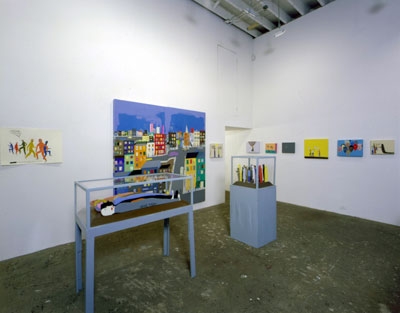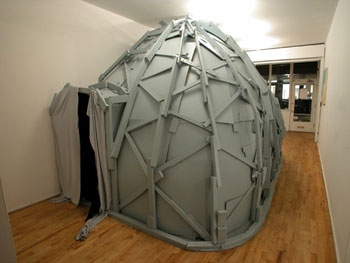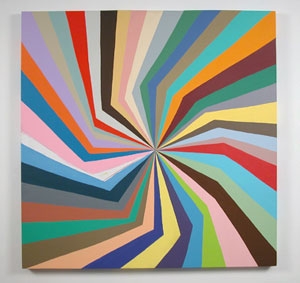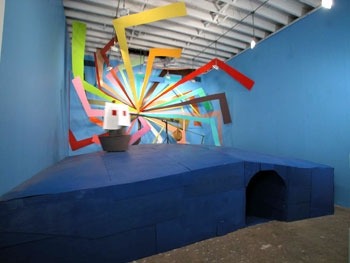Feature: Reviews
Chris Johanson: Now is Now
- Deitch Projects
- 76 Grand St., New York, New York 10013
- November 2 - December 21, 2002
It couldn’t have been closer to the eleventh hour when we pulled up to 76 Grand. If actually driving in Manhattan, let alone Soho, hadn’t already unnerved us, witnessing the Deitch Gallery’s state of disarray so close to reception hour would have done it. Chris Johanson stood across the room, still painting, in deep concentration. Truth be told, he wore the expression of a man slightly possessed. Fifty or so gallon paint cans,organized into a tapestry of pastels, sat at his disposal on the concrete floor. He grabbed them at will and worked. A line gathered outside.
Around the gallery, assistants filmed, swept, stacked copies of There You Are (the book that acted as a last-minute fill-in for the Now is Now book still in press), unpacked posters and chilled the cider Johanson had requested be on hand for the hordes set to descend upon the space. Preparators took a moment to take in the work they’d done. An air of expectation filled the gallery like a storm cloud about to clear.
A few months prior, Johanson had affectionately asked Tussle, the band in which I play, if we’d like to perform at his opening, along with The Coachwhips, a Panic-Garage trio with whom we were touring. Chris thought it a timely event to bring a bit of San Francisco to Manhattan. On the show’s poster - a space typically reserved for the artist’s art only - Johanson thanked each person involved in the show, pointing out that “All of these are from San Francisco” in his trademark irregular paintbrush scrawl. Unlike so many artists, who claim a stake in a “scene” until they can distinguish themselves from it, Johanson’s recent successes have, if anything, only intensified his esprit de corps. Indeed, his spirit of gratitude for the handful of friends and associates who helped with the construction of his installations was large nearly became the theme of the show (see “A Most Excellent Workshop”). That said, his desire to shed light on San Francisco was not only a gesture towards his friends, colleagues and the often underestimated Bay Area art scene. It was a gesture intended to throw light on life outside New York for a moment.
Utopia Gone Wrong
Upon entering, visitors were greeted with a strange oblong site. Not so much tucked into as protruding from the far corner stood a lopsided dome that could only be described as the kind of geodesic dome Buckminster Fuller’s estranged, dyspeptic children might have constructed. Painted in flat, grey-scale blue, it poked out its “joints” of right-angled two-by-fours like a signifier of a future modernity gone wrong.
What existed inside the dome confirmed Johanson’s view that the future we’ve made for ourselves couldn’t be further from Fuller’s utopian theories. After passing through a curtain of velour, one was greeted by thick, ink-black darkness. The only source of light a lightbulb with the word “US” scrawled upon its surface. Solitude is forced upon each visitor, even as he or she is all the while bumping into and rubbing shoulders with others inside. Seeing the word “US” lit up, alone, surrounded in such darkness, it seemed nearly impossible not to interpret the words as a signifier of both the fear we have of one another in the United States and the current U.S. administration’s jingoistic narcissism. A physical metaphor for the new American isolationism. No other place exists, the setup seemed to imply. We, us, the US, the forces of/in darkness. We, too alone to really know those “others” in such close physical and mental proximity. The lightbulb provides the symbolic and real moment of insight. In trademark counterpoint, a painting across the room featured a woman with a golden, upside-down triangle of light radiating from her cerebellum, a sly, spiritually kitschy and earnest recognition of the power of each person’s singular mind.
Words Fold In On Themselves
The fact is, Johanson has a way with words. His snide observations, flavored equally with hope so ardent as to be twisted or thoughts so ostensibly over the top as to cause embarrassment, lie tangled upon his city vignettes and panned-out aerial views. The cosmology he’s created is something of a neurotic, confessional urban neighborhood very much informed by a Golden State upbringing. Indeed, much of his tone riffs on The Californian dialect’s cliché idioms. It’s a mural of interior thoughts, the thrust of which is the way he treads the tightrope he runs. Utopian statements neighbor wry puns. New Age-isms appear contradictorily in unforgiving urban climates. Insights are found in the most unlikely places. Like the communal spirit surrounding Now is Now, the title itself (an underhanded nod to Ram Dass’s Be Here Now) folds in on itself.
Not far from David Shrigley in his sensibility for the absurd and naïve, Johanson likes to fuck with you for a laugh. Witness A Most Excellent Workshop where he concocts a lankier offspring of Teletubbies, busy prancing about, chanting “This is a most excellent workshop.” Like some warped riddle combining a twisted Oprah Winfrey or Deepak Chopra “life-transforming workshop,” he simultaneously offers his genuine view on his experience working with his friends and colleagues and wry commentary on therapy and infomercial culture. And in some strange way, it works like a charm, partly because he hopes you’ll get both the joke and the larger point. His work is elementally about our forced togetherness and our perpetual inclination towards alienation, whether imposed upon us or by ourselves.
Updating his Energy Burst series, Johanson dropped a technicolor swirl of L-shaped strands resembling swastikas in a new painting, a sort of Energy Burst - Mach 2, which looked not unlike what a Peter Halley might look like if caught in the thrust of a tornado, a recontextualized op art working with ancient/future symbology.
The expansion of Johanson’s color palette - which adds an expressive quality reminscent of early Peter Saul or occasionally the sherbert wrappings of some Donald Baechler - was on full display. A look at You Are There, first published in 2000, emphasizes this shift. His naif, intentionally “untrained” style tended towards the monochrome as he was working primarily with black ink on recycled brown paper, something that only intensified comparisons to Raymond Pettibon and other graphic artists. And though the vernacular of his cosmology was very much intact, and though it very much offered numerous grains of wisdom and hilarious insight, it seems he’s only now really reaching his best work.
In any case, it was the third room which merited the most notice. With a giant version of the pastel swastika swirl taking up the entire rear wall, an installation stood in front. A boat, mechanized by a cog-driven machine (Johanson created a crawl space for viewers to take in the cogs in action), circled over a sprawl of blue-painted wood. The boat chased a bag of money overtop a raw lumberyard ocean of wood. There was a strange equilibrium in the way the boat and money circled each other, equalizing each other. It turned endlessly throughout the exhibit, mirroring the endless chase for power and capital currently informing the current state of affairs. Simple though it is, like Now is Now, it’s no less poignant for that simplicity.




